WHAT YOU REALLY NEED TO KNOW
ABOUT COSMETIC SURGERY
Full Text from Dr. Berman's Book
Chapter 14
ABDOMINOPLASTY
(Tummy Tuck)
While liposuction can remove unwanted fat cells, if there is considerable laxity of the abdominal muscles and excessive skin, particularly following childbirth or very large weight loss from other reasons, then an abdominoplasty (so called, tummy tuck) might be more beneficial.
During childbirth or large weight gains, the abdominal muscles are often stretched to such a point that they never regain their pre-birth tightness. This condition is referred to as diastasis recti. With weak abdominal muscles, the intestines tend to push forward. This can put a considerable strain on the spine causing a fair amount of back pain. It may even cause some difficulty with bowel movements. The skin, during pregnancy, actually grows. (This concept has actually helped promote the idea of skin expansion in plastic surgery.) Unfortunately, when the skin is so abundant following childbirth or large weight gains, liposuction alone can not account for adequate shrinkage. The excess apron of skin and fat needs to be surgically removed.
In order to achieve a flatter, tighter abdomen without the excess skin an abdominoplasty (tummy tuck) is performed. It is generally an out-patient procedure done in the office surgical suite, but under certain circumstances can be done in the hospital with an overnight stay. The procedure is generally performed under general anesthesia, but in select cases it can be performed under intravenous sedation and local anesthesia (usually smaller, thinner individuals). The 2 - 4 hour procedure involves elevating (separating) the skin and fat from the underlying abdominal muscles. The belly button (umbilicus) is cut out from the skin and left connected to the deep tissues from which it originated. The muscles are then tightened, making the waist more narrow and restoring their pre-stretched out position. The excess skin and fat are excised and the new flap is sutured to the bikini line incision site. A hole is made where the belly button lies under the flap, and then it is reconnected to its new site.
Drains are often used and removed within 3 - 7 days. The sutures are usually removed after one week. Walking (ambulating) is allowed and encouraged immediately, even if you need to walk somewhat bent over to minimize tension on the wound closure. In fact, walking is the most important thing in preventing the worse complication of abdominoplasty - pulmonary embolism from a clotted (thrombotic) leg vein. In the "old days", we would confine the patient to bed for 48 hours. I'm not sure this helped the wound as much as it increased the risk of thrombosis. Infection is a possible complication, yet fortunately quite rare. The biggest risk of infection is probably from bacterial contamination up through the drain site. This can be minimized by keeping the drain sites clean and covered with antibiotic ointment. Poor healing of the scar is another risk. The scar usually starts healing promptly with typical redness which ultimately fades over time (one year). In rare circumstances, if there is compromise to the blood flow within the skin (flap), the tissue around the scar can breakdown, resulting in a dehiscent wound (the tissues die and the wound separates). Such a problem requires conservative care and patience until it heals. There can also be some contour irregularities that might require further treatment or perhaps a little liposuction.
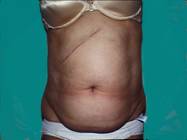
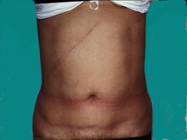
A patient with a large apron of skin and fat draping over the pubic area. She also has lax abdominal muscles and an old scar from gall bladder surgery requiring special care. Following abdominoplasty the patient has an improved abdominal contour.
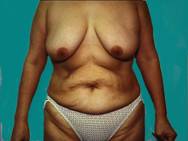
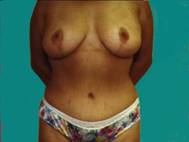
Sometimes patients need to be treated in stages. This patient first underwent liposuction around the abdomen and thighs. Following an adequate time for healing, she then underwent an abdominoplasty as well as a breast lift procedure. Improving her contours did a lot for her self-esteem and general happiness.
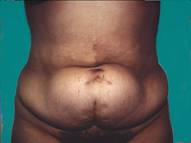
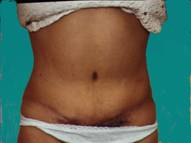
This young patient had multiple pregnancies, two through caesarean approach, and she also had two previous operations to repair a ventral hernia. She underwent an abdominoplasty. At the time of surgery, she had a large ventral hernia which was repaired definitively. So in this case, the patient has improved both a cosmetic and a functional problem.